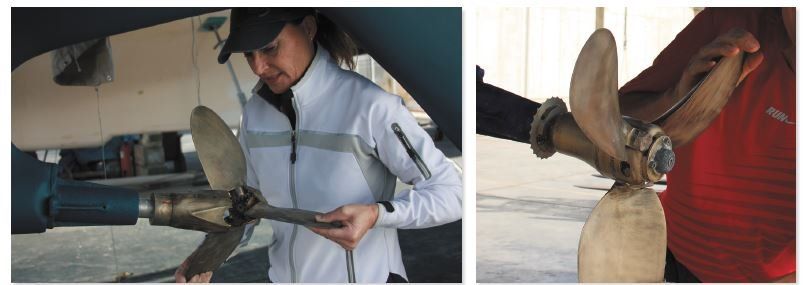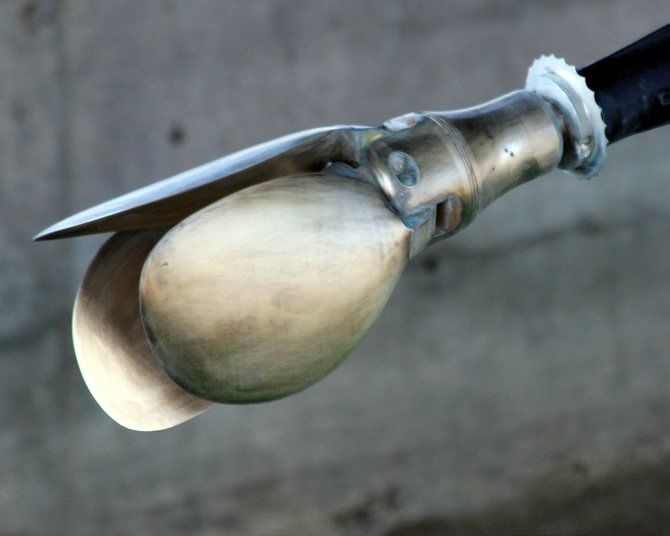For the past 40 years we’ve sailed an average of 10,000 miles annually between Australia, Alaska, Antarctica and Spitsbergen motoring or motorsailing between 400 and 600 hours, depending on the area – more hours in high latitudes of Antarctica and the Arctic, fewer in the tropical trade winds.
Our HR 42 came with a fixed three-blade prop which served us well when pushing bergy bits out of the way in Patagonia, Antarctica and Alaska, but obviously slowed us down in light airs. When we had our current Hallberg-Rassy 46 built in 1996, anticipating better sailing performance, we opted to install a Max-Prop as that was acknowledged as the best option at that time.
Max-Prop has been around since the early 70s and is a proven design, but after 18 years and 190,000 miles of use, we had the prop rebuilt three times, each time costing between $800 and $1,200. The first time the prop was rebuilt by Henleys, an Auckland prop shop, and the other two times by PYI, the U.S. importer/distributor located near Seattle. I was told that the rebuild included brazing more bronze on to the props inside working surfaces followed by machining the built-up surfaces down to original tolerances. When I enquired what I could do to extend the period of time between rebuilds, PYI said, More grease! So for 15 years, we not only greased the prop before launching at the start of our season, but also mid-season going underwater with mask, fins and grease gun to do so.
The advantages of the Max-Prop are very little drag when sailing as the prop instantly feathers unless the engine is engaged, no freewheeling in neutral, adjustable pitch, and incredible stopping power in reverse. Max-Prop can literally bring a boat from 6 knots to a dead stop in a boat length. This feature has kept us from nailing coral heads at least twice. The ability to adjust the pitch to maximum engine efficiency improves fuel economy and the newer Easy model Max-Props can be adjusted in the water without having to disassemble and reassemble the propeller, which is a substantial improvement over the earlier Classic version. We did encounter (and frequently use to our advantage) fairly substantial propwalk.

The disadvantages are that when the Max-Props feathers, the blades are still open and prone to fouling lines and kelp. During our 2008 Atlantic crossing we had to get in the water with mask and fins three times to remove cargo nets and large 3-inch floating lines from the prop. The Atlantic Ocean has a garbage gyre similar to, but smaller than the Pacific Garbage Patch, and we must have found the edge of it during our 2008 crossing. Last month, we completed the identical route from the Canary Islands to Antigua with only one sighting of trash and favorable winds that allowed us to basically sail the rhumbline. As a funny side note we were once making landfall at Fastnet Rock when a smaller boat passed us under sail. Trim as we might, we couldn’t catch them and only when they were several boat lengths ahead did Amanda think to check astern only to discover a fat turquoise rope trailing behind. The rope, obviously was not ours, was caught on the prop and we wondered how long it had been there as we’d not used the motor for several days.
Flexofold
During a 2015-2016 winter refit in Sweden, after reading the results of two European propeller efficiency tests and after speaking with several owners who had switched from Max-Prop to Flexofold, I had a Flexofold prop installed. Jack Skrydstrup, Flexofolds Danish manufacturer recommended the size and pitch, and the boatyard installed it without problems.
In comparison the stopping power is not nearly as good as with the Max-Prop, and the prop freewheels when the engine is shut down in neutral. Weve found that shutting down in slow forward solves the freewheeling issue. Strong on the Flexofolds plus side are blades that feather aft, instead of extended, so they’re less likely to snag lines or kelp. We notice almost no propwalk in reverse. In addition, cost of ownership is reduced as there doesn’t appear to be a need to rebuild and there are considerably fewer spare parts to carry.
However, the improvements in efficiency are difficult to quantify as we also repowered at the same time, switching from a 95 hp. to 75 hp. engine, but our top speed rose 0.7 knots, and fuel consumption on an identical Atlantic crossing dropped from 1.33 gph to .83 gph.
On the service side, PYI, the U.S. importer/distributor of Max-Prop is renowned for their customer service, doing a superb job of shipping spare parts immediately and quickly handling rebuilds from their shop near Seattle. Flexofolds Jack Skrydstrup is helpful, and ships quickly, although shipping is factory-direct from Denmark. Ive only heard one incident of an owner needing parts during European summer vacation period when shipping was delayed slightly.
Amanda and John Neal spend seven months at sea sailing 10,000 miles a year while leading sailing training expeditions. The have more than 500,000 sea miles combined experience.

Nigel Calder, author of The Boatowners Mechanical and Electrical Manual shared propeller data collected during the course of his recent hybrid propulsion experiments. Here’s his summary: “We tested Flexofold, three Goris, two Volvo-Penta fourblade folding props, three Brunton Autoprops, a Brunton Varifold, and a fixed pitch, which was undersized so not a fair comparison it just happened to be available. The objective of these tests was to collect baseline data for other purposes. As such, the propellers were not necessarily properly matched to the boat and these are not apples-to-apples comparisons.
“The Flexofold, Volvo-Pentas and Varifold had similar efficiencies, but from an engineering perspective the Flexofold was the simplest design and easiest to fit.”








































Our experience with Flexofold is that they have not stood behind their size / pitch recommendation. Great prop otherwise — well made and much more efficient than our Max Prop.
I am considering installing a Brunton Autoprop on my 34’ Vashon cutter (26’ LOD), 6500# displacement. Has anyone had experience with these props and/or what is your opinion of installing this type of feathering prop?
It would be helpful if you labeled the pictures so that us less knowledgeable sailors knew what prop we were looking at. Very good overview article considering all of the variables involved. It provided some insight. By way of an example, I tried 3 different props on my dingy before I found the best fit for my needs; a boat is more complicated.
I absolutely love the concept of the Autoprop. After having held one at a boat show, and seeing a cutaway model, I still can’t figure out how it works, but that doesn’t stop it from being brilliant. Alas, when we re-propped our Marshall 22 catboat, there wasn’t enough room for any of the Autoprop line.
We chose a 12″ three-bladed Featherstream and are very happy with it. On the downside, you have to remove a pitch “cassette” (a specifically-sized arc of metal) and replace it with a different size in order to change the pitch. But on the upside, man is that simple. You don’t even have to fully-disassemble the prop to do it. A fellow at the boatyard watched wistfully as he talked about having to disassemble is feathering prop and try to figure out which detent a screw would fit into when covered with grease.
The price was also quite reasonable, and service from Canada has been great.